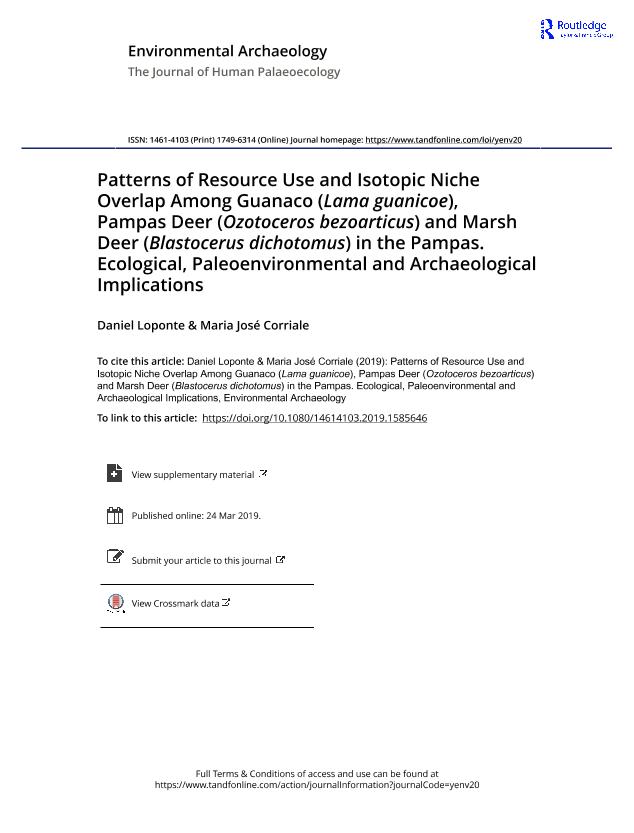Mostrar el registro sencillo del ítem
dc.contributor.author
Loponte, Daniel Marcelo

dc.contributor.author
Corriale, Maria Jose

dc.date.available
2022-01-28T20:15:57Z
dc.date.issued
2019-02
dc.identifier.citation
Loponte, Daniel Marcelo; Corriale, Maria Jose; Patterns of Resource Use and Isotopic Niche Overlap Among Guanaco (Lama guanicoe), Pampas Deer (Ozotoceros bezoarticus) and Marsh Deer (Blastocerus dichotomus) in the Pampas. Ecological, Paleoenvironmental and Archaeological Implications; Taylor & Francis; Environmental Archaeology; 25; 4; 2-2019; 411-444
dc.identifier.issn
1461-4103
dc.identifier.uri
http://hdl.handle.net/11336/150923
dc.description.abstract
In this paper, we analyze the isotopic niche and resource use of the guanaco (Lama guanicoe), pampas deer (Ozotoceros bezoarticus) and marsh deer (Blastocerus dichotomus) on the temperate plain of the northern Pampa region in the southeast of South America. The measured stable isotope compositions in bone tissue are δ13C, δ15N and δ18O. All the analyzed samples were recovered from different archaeological sites from the late Holocene. According to the results, the guanaco was strictly confined to the Pampa plain environment, developing a broad niche based on C3 plants and a variable contribution of C4 grasses within a grazing trend. The pampas deer preferentially used the Pampa plain, but also the prairies on the borders of the wetland, showing eurioic characteristics and a narrower niche based on C3 plants. In turn, the marsh deer was strictly confined to wetland environments, developing a C3 diet–base, within a narrow isotopic niche and stenoic characteristics. The three mammals showed a wide range of intraspecific variability, which was a key factor in their adaptability to spatial and temporal changes in the vegetation coverage. In fact, the temporal trends of their isotopic values were concurrent with the major climatic variations of the Holocene. Differences in the correlations between the values of both carbon sources in both deer species compared with the guanaco suggest a distinct chemical composition of their diet and/or differences in the allocation of nutrients. The isotopic values of nitrogen and spacing of the carbon sources in guanaco (pseudoruminant) and both deer species (ruminants) show no significant differences between them, thus establishing the values for local large herbivores. Significant correlations between δ13C and δ15N were found in the guanaco and marsh deer. The regional and extra–regional variability in the guanaco’s δ13Ccollagen and δ15N probably reflect the clinal variations in the vegetation coverage and the amount of rainfall. The collagen isotope values in the guanaco throughout the entire Holocene show that the humid Pampa would have shifted between being a more recurrent mesic and temperate plain with minor phases of dry–mesic conditions like during the Little Ice Age, and a humid and warm one at the peaks of the Holocene Thermal Maximum and the Medieval Climatic Anomaly. The guanaco and the pampas deer adapted to all the climatic changes that happened on the humid Pampa until the biological invasions of large European mammals changed the herbivores’ guild composition of this vast plain, pushing them into peripheral habitats due to competition. The within–species variability in isotopic signals through time and space make it necessary to carry out adequate sampling before reconstructing the diets of local past populations.
dc.format
application/pdf
dc.language.iso
eng
dc.publisher
Taylor & Francis

dc.rights
info:eu-repo/semantics/openAccess
dc.rights.uri
https://creativecommons.org/licenses/by-nc-sa/2.5/ar/
dc.subject
Guanaco
dc.subject
Pampas deer
dc.subject
marsh deer
dc.subject
Pampa region
dc.subject
isotopic niche
dc.subject
Holocene climatic variations
dc.subject.classification
Otros Tópicos Biológicos

dc.subject.classification
Ciencias Biológicas

dc.subject.classification
CIENCIAS NATURALES Y EXACTAS

dc.subject.classification
Arqueología

dc.subject.classification
Historia y Arqueología

dc.subject.classification
HUMANIDADES

dc.title
Patterns of Resource Use and Isotopic Niche Overlap Among Guanaco (Lama guanicoe), Pampas Deer (Ozotoceros bezoarticus) and Marsh Deer (Blastocerus dichotomus) in the Pampas. Ecological, Paleoenvironmental and Archaeological Implications
dc.type
info:eu-repo/semantics/article
dc.type
info:ar-repo/semantics/artículo
dc.type
info:eu-repo/semantics/publishedVersion
dc.date.updated
2020-11-20T14:50:38Z
dc.journal.volume
25
dc.journal.number
4
dc.journal.pagination
411-444
dc.journal.pais
Reino Unido

dc.description.fil
Fil: Loponte, Daniel Marcelo. Secretaría de Cultura de la Nación. Dirección Nacional de Cultura y Museos. Instituto Nacional de Antropología y Pensamiento Latinoamericano; Argentina. Consejo Nacional de Investigaciones Científicas y Técnicas; Argentina
dc.description.fil
Fil: Corriale, Maria Jose. Consejo Nacional de Investigaciones Científicas y Técnicas. Oficina de Coordinación Administrativa Ciudad Universitaria. Instituto de Ecología, Genética y Evolución de Buenos Aires. Universidad de Buenos Aires. Facultad de Ciencias Exactas y Naturales. Instituto de Ecología, Genética y Evolución de Buenos Aires; Argentina
dc.journal.title
Environmental Archaeology
dc.relation.alternativeid
info:eu-repo/semantics/altIdentifier/doi/http://dx.doi.org/10.1080/14614103.2019.1585646
dc.relation.alternativeid
info:eu-repo/semantics/altIdentifier/url/https://www.tandfonline.com/doi/full/10.1080/14614103.2019.1585646
Archivos asociados
